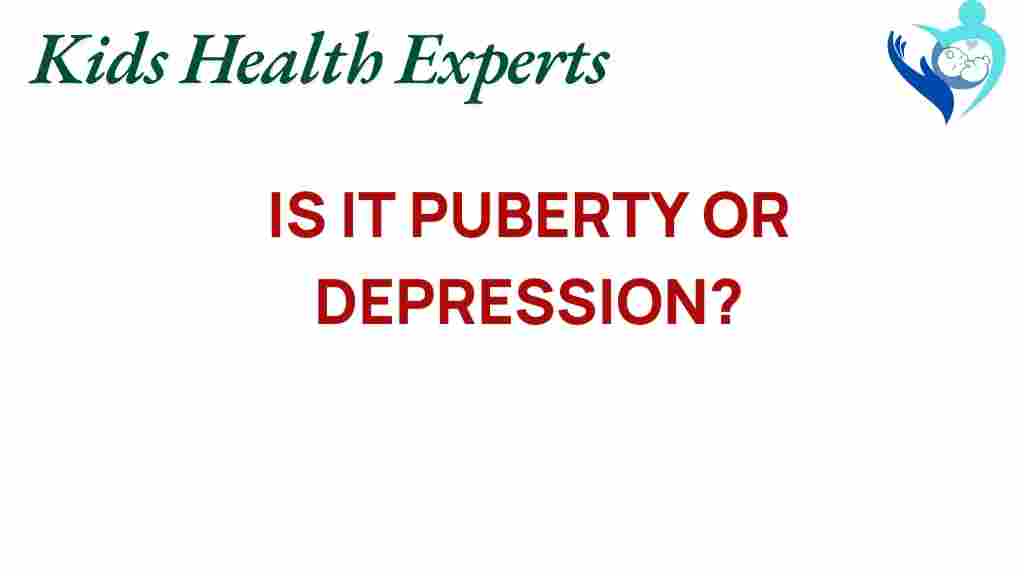Is It Puberty or Depression? Understanding the Signs of Adolescence
Adolescence is a critical stage in human development characterized by significant physical, emotional, and psychological changes. During this period, many young people experience a whirlwind of emotions as they transition from childhood to adulthood. This stage, often marked by puberty, can also coincide with mental health challenges such as depression. Understanding the signs of puberty and depression is essential for parents, educators, and adolescents themselves to navigate this complex phase of life effectively.
What is Puberty?
Puberty is a natural biological process that typically occurs between the ages of 9 and 14 for girls and 10 to 15 for boys. It involves a series of physical changes driven by hormonal shifts. These changes include:
- Growth spurts
- Development of secondary sexual characteristics (breast development in girls, voice deepening in boys)
- Menstruation in girls
- Increased oil production in skin and hair
During this time, adolescents may also experience emotional changes that can sometimes be confused with symptoms of depression. Recognizing what is typical during puberty versus what may indicate a mental health issue is crucial for youth wellbeing.
Understanding Depression in Adolescents
Depression is a mental health disorder that can affect anyone, including adolescents. It can manifest in various ways, and understanding these signs is essential. Common symptoms of depression in teenagers include:
- Persistent sadness or low mood
- Loss of interest in activities once enjoyed
- Changes in appetite or weight
- Sleep disturbances (insomnia or excessive sleeping)
- Feeling irritable or angry
- Difficulty concentrating
- Thoughts of self-harm or suicide
It is important to note that while emotional changes are a normal part of puberty, persistent symptoms of depression may indicate a need for professional help.
Recognizing the Signs of Adolescence
Both puberty and depression involve emotional changes, but there are distinct signs that can help differentiate between the two. Here are some key indicators to consider:
Physical Changes vs. Emotional Changes
During puberty, physical changes are evident, such as growth spurts and the development of secondary sexual characteristics. However, emotional changes can be more subtle and complex. For instance:
- Puberty: Mood swings are common due to hormonal fluctuations.
- Depression: Mood changes are more persistent and may include feelings of hopelessness.
Social Interactions
Adolescents undergoing puberty may become more self-conscious and socially aware, leading to changes in how they interact with peers. However, signs of depression may include:
- Avoidance of social situations and friends
- Withdrawal from family and previously enjoyed activities
Academic Performance
Changes in academic performance can occur during puberty due to distractions or new interests. In contrast, depression may lead to:
- Significant decline in grades
- Difficulty concentrating on schoolwork
- Absences from school
Handling Teenage Challenges
Adolescents face numerous challenges, including peer pressure, academic expectations, and identity exploration. Here are some factors that may contribute to emotional changes:
- Peer Relationships: Navigating friendships and romantic interests can be stressful.
- Family Dynamics: Changes in family structure or conflicts can impact emotional health.
- Academic Pressure: The stress to perform well in school can lead to anxiety and depression.
Steps to Differentiate Between Puberty and Depression
Identifying whether a young person is experiencing normal puberty-related emotional changes or signs of depression involves a systematic approach:
- Observe the Duration: Emotional changes during puberty are typically temporary, while depressive symptoms persist for weeks or months.
- Assess the Severity: Consider whether the emotional changes interfere with daily life, such as social interactions, school performance, and overall wellbeing.
- Seek Feedback: Talk to the adolescent about their feelings and experiences. Encourage open communication about their emotional state.
- Consult Professionals: If there are concerns, consider seeking advice from a mental health professional who specializes in adolescent health.
Troubleshooting Tips for Parents and Caregivers
As a parent or caregiver, understanding the nuances of adolescence can be challenging. Here are some tips to support young individuals during this crucial stage:
Encourage Open Communication
Creating a safe space for adolescents to express their feelings is vital. Here are ways to foster communication:
- Engage in regular conversations about their day-to-day experiences.
- Listen without judgment, validating their feelings and emotions.
- Encourage them to talk about friendships, school, and any pressures they may feel.
Promote Healthy Lifestyle Choices
Encouraging healthy habits can significantly impact emotional wellbeing:
- Physical Activity: Regular exercise can enhance mood and reduce symptoms of depression.
- Balanced Diet: A nutritious diet fuels both the body and the mind.
- Sleep Hygiene: Encourage consistent sleep patterns to support overall wellbeing.
Seek Professional Help When Necessary
If signs of depression persist or worsen, seeking professional help is crucial. Mental health professionals can provide:
- Assessment and diagnosis of mental health issues
- Therapeutic interventions tailored to the adolescent’s needs
- Support for families to better understand and manage adolescent challenges
Foster a Supportive Environment
A supportive home environment can greatly enhance an adolescent’s resilience:
- Encourage participation in hobbies and interests that promote joy.
- Be involved in their academic life, providing assistance and encouragement.
- Promote strong family bonds through shared activities and quality time.
Conclusion
Understanding the distinction between puberty and depression is crucial for supporting adolescents through their emotional changes. While puberty is a natural part of psychological development filled with ups and downs, mental health challenges like depression require attention and care. By recognizing the signs of both puberty and depression, fostering open communication, and promoting youth wellbeing, parents and caregivers can help navigate the teenage challenges that arise during this pivotal stage of life.
For further information on adolescent mental health, consider visiting this resource. If you or someone you know is struggling with depression, don’t hesitate to reach out for help.
Remember, understanding and support can make a significant difference in the lives of adolescents as they grow and develop.
This article is in the category Mental and created by KidsHealthExperts Team
